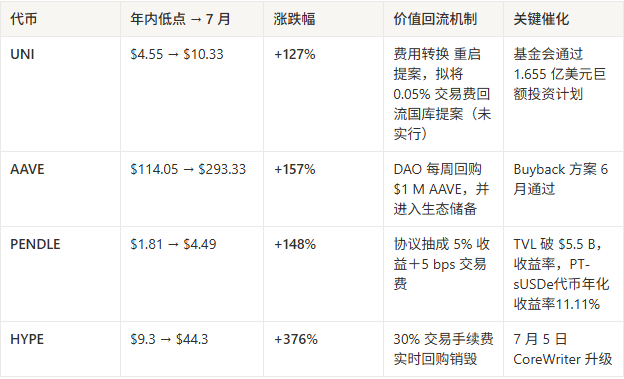At the beginning of 2025, as secondary market liquidity tightened, many altcoins driven by 'story + airdrop' had their bubbles ruthlessly popped.
Countless altcoins have continued to decline to new lows—while during the same period, Bitcoin's market cap share rose to 62.1%, a five-year high, and the Altcoin Season Index even reached a record low of 4 points in May 2023.
However, 'utility tokens' like Uniswap (UNI), Aave (AAVE), Pendle (PENDLE), and Hyperliquid (HYPE) attract funds flowing upstream, with prices and on-chain income rising simultaneously.
They share a common feature: real, auditable protocol cash flow, which returns value to token holders through buybacks, profit sharing, or staking.
This article attempts to outline the logic of capital migration after the VC bubble bursts and uses four representative projects as samples to explore how the 'on-chain P/E era' is reshaping the crypto valuation system.
Market background: As the narrative recedes, cash flow becomes a scarce commodity
VC slowdown: In Q2 2025, global crypto financing plummeted to $4.99 billion, down 21% quarter-over-quarter, hitting a new low since 2020, as investors became cautious about 'concept speculation'.
Funds are flowing back to blue-chip DeFi: Bitcoin continues to strengthen its dominance, but there is a significant internal divergence within the DeFi sector; protocols with an 'income-distribution' closed loop see their TVL and trading volume continue to rise. Pendle's TVL surpassed $5.59 billion in July, nearly tripling year-to-date.
Shift in valuation anchors: During traditional risk aversion cycles, investors are more willing to pay for quantifiable cash flows rather than pure narrative premiums.
What is a 'utility token'?
Definition: Token holders can share protocol revenues (Fee Capture), or enhance each token's 'on-chain EPS' (verifiable earnings per token) through buybacks/burns and staking profit sharing.
Typical model
Fee Switch / trading profit-sharing: Proportionally returning or buying back protocol fees (e.g., GMX).
Lending spread & liquidation fees: Allocating spreads and liquidation rewards to the treasury for buybacks (AAVE, Maker).
Yield tokenization: Splitting future earnings for trading, with the protocol taking a cut (Pendle).
Infrastructure fuel: High-frequency matching engine fees are instantly bought back and burned (HYPE).
Overview of four major cases

Breakdown: How does cash flow drive valuation recovery?
Uniswap (UNI)
Previously, the market regarded UNI as a 'pure governance token'. Subsequently, the Uniswap Foundation voted to approve a massive investment plan of $165.5 million. The Uniswap Foundation proposed to allocate $165.5 million to the following areas.
· $95.4 million allocated for funding (developer programs, core contributors, validators);
· $25.1 million allocated for operations (team expansion, governance tool development);
· $45 million allocated for liquidity incentives.
Currently, the $UNI token has no substantive token value capture or buyback plan!
Aave (AAVE)
Aave DAO approves a weekly buyback of approximately $1 million AAVE using protocol surplus, locking it into the DAO inventory:
The first week of execution pushed the intraday increase by 13%, with trading volume doubling.
The lending spread + liquidation fees stabilize cash flow, coupled with a 32% year-over-year increase in V3 TVL, making the buyback plan a long-term ammunition.
Pendle (PENDLE)
Pendle brings the derivative narrative of 'future earnings' into a trading market:
Extracting 5% revenue + 5 bps trading fee generates auditable income daily for the protocol.
High-yield strategies (e.g., stETH YT yield once exceeded 11%) are more attractive in a low-interest-rate environment, with continuous inflow of funds.
Hyperliquid (HYPE)
As a high-frequency matching DEX, Hyperliquid launched the CoreWriter precompiled in July, allowing HyperEVM contracts to place orders, settle, and call CLOB directly, with an on-chain fee buyback and burn mechanism:
During the upgrade week, on-chain active addresses and trading volume both reached historical highs.
The immediacy of value return + the scale of high-frequency trading fees make HYPE a strong β for the 'on-chain cash flow' narrative.
Three moats to survive the bear market
Deterministic cash flow: On-chain income & expenditures are auditable, DAO resolutions are publicly transparent, reducing information asymmetry.
Buyback / profit-sharing closed loop: Writing the 'protocol income → token value' path into smart contracts creates effects equivalent to stock buybacks or dividends.
Institution-friendly: Quantifiable yield indicators (P/S, P/E) reduce valuation uncertainty, facilitating market making and structured product design.
Summary
After the VC narrative recedes, the market is re-pricing 'verifiable cash flows'.
Utility tokens integrate on-chain income, token value, and governance rights, making them a scarce asset across cycles.
As mainstream DeFi protocols gradually introduce Fee Switch (fee conversion), buybacks, or surplus distributions, it signifies a shift in crypto market valuation logic from a 'narrative market' to a 'cash flow market'.
$uni $aave $pendle $hype #defi #altsesaon